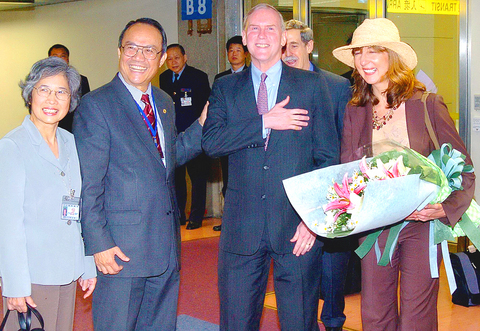The new American Institute in Taiwan (AIT) director Stephen Young arrived in Taipei yesterday to assume his post as head of the US' de facto embassy in Taiwan.
In a statement upon his arrival, Young spoke at length in praise of the democratic development of Taiwan over the last decade.
"I am sure to rediscover the dynamism and optimism of the Taiwanese people, which has made this one of the most vibrant places in the Asia-Pacific region," Young said.

PHOTO: CHU PEI-HSIUNG, TAIPEI TIMES
"I look forward to reacquainting myself with the strong democratic values that have been emerging now for nearly twenty years, and which President Bush so warmly described in his Tokyo speech last November," he said.
The new AIT director also reaffirmed the US commitment to help Taiwan defend itself in the face of an increasingly self-confident China.
"This has posed new security challenges for Taiwan which the United States, under the Taiwan Relations Act, remains committed to closely cooperating on with you," Young said.
Young, a former US ambassador to Kyrgyzstan from 2003 to last year, was also deputy AIT director from 1998 to 2001.
It's the fifth time he has returned to Taiwan. Young first came to Taiwan at the age of 12 with his father, who served as a military adviser to the Taiwanese army in Kaohsiung from 1963-1965.
Young speaks fluent Mandarin and holds a doctorate in history from the University of Chicago.
He arrived yesterday with his wife and son.

Taiwan is to commence mass production of the Tien Kung (天弓, “Sky Bow”) III, IV and V missiles by the second quarter of this year if the legislature approves the government’s NT$1.25 trillion (US$39.78 billion) special defense budget, an official said yesterday. Commenting on condition of anonymity, a defense official with knowledge of the matter said that the advanced systems are expected to provide crucial capabilities against ballistic and cruise missiles for the proposed “T-Dome,” an advanced, multi-layered air defense network. The Tien Kung III is an air defense missile with a maximum interception altitude of 35km. The Tien Kung IV and V

The disruption of 941 flights in and out of Taiwan due to China’s large-scale military exercises was no accident, but rather the result of a “quasi-blockade” used to simulate creating the air and sea routes needed for an amphibious landing, a military expert said. The disruptions occurred on Tuesday and lasted about 10 hours as China conducted live-fire drills in the Taiwan Strait. The Civil Aviation Administration (CAA) said the exercises affected 857 international flights and 84 domestic flights, affecting more than 100,000 travelers. Su Tzu-yun (蘇紫雲), a research fellow at the government-sponsored Institute for National Defense and Security Research, said the air

Taiwan lacks effective and cost-efficient armaments to intercept rockets, making the planned “T-Dome” interception system necessary, two experts said on Tuesday. The concerns were raised after China’s military fired two waves of rockets during live-fire drills around Taiwan on Tuesday, part of two-day exercises code-named “Justice Mission 2025.” The first wave involved 17 rockets launched at 9am from Pingtan in China’s Fujian Province, according to Lieutenant General Hsieh Jih-sheng (謝日升) of the Office of the Deputy Chief of the General Staff for Intelligence at the Ministry of National Defense. Those rockets landed 70 nautical miles (129.6km) northeast of Keelung without flying over Taiwan,

City buses in Taipei and New Taipei City, as well as the Taipei MRT, would on Saturday begin accepting QR code payments from five electronic payment providers, the Taipei Department of Transportation said yesterday. The new option would allow passengers to use the “transportation QR code” feature from EasyWallet, iPass Money, iCash Pay, Jkopay or PXPay Plus. Passengers should open their preferred electronic payment app, select the “transportation code” — not the regular payment code — unlock it, and scan the code at ticket readers or gates, General Planning Division Director-General Liu Kuo-chu (劉國著) said. People should move through the